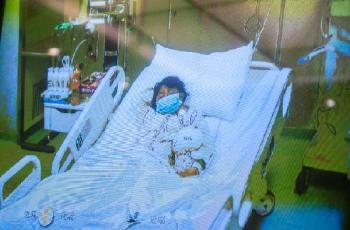Why the Chinese are experimenting with Peramavir
UPDATE: As of 10am EDT today, China is at 64 confirmed cases and 14 deaths.
It's not easy being a flu blogger these days. People such as Crof and Mike Coston are engaged in what I will now coin "sweat-shop blogging." This means they are sitting at their computers, heads down, typing feverishly as if they are getting paid by the word.
Of course, the thing is: They do not make money at this. They don't work foir Huffington (and it's a good thing for them!). They do it because they are helping everyone understand and deal with the ramifications of emerging pathogens. In my opinion, they, and other respectable bloggers like them (I am looking at you, Maryn McKenna), should receive some sort of medal. Or free bandwidth. Or both.
Anyway, I cannot hope to maintain their pace. I do, however, make notes to myself to talk about things that I think have consequence.
So it is that an early dispatch from China at the beginning of this H7N9 outbreak caught my eye, and I filed it away for future reference. When assembled with another dispatch, I think it speaks volumes about why the Chinese are experimenting with different protocols in the treatment of their H7N9 patients.
It was Giuseppe Michieli, another intrepid flu blogger from Italy, who posted this article on FluTrackers.com at the onset of the H7N9 outbreak. The Chinese equivalent of the FDA gave emergency approval for peramavir to be used in the treatment of H7N9 bird flu patients.
Peramavir is the invention of Bio-Cryst Pharmaceuticals of Durham, North Carolina/Birmingham, Alabama. Back in 2007, Bio-Cryst made headlines with the news it had created an antiviral medicine, administered through the vein, that did things that Tamiflu and Relenza could not. My comprehensive blog on that topic is here.
Did I also mention it was a visionary blog? When I talked about the CDC's apparent failure to manufacture a pandemic virus in September of 2007, I asked:
...the CDC was unable to kick-start a reassortant H5N1/H3N2 virus. Thus, the CDC concluded, it was difficult to imagine such a reassortant occurring naturally. I cannot tell you why they did not try an H7 or H1 virus. You'll have to ask them.
Wow. I had forgotten that! Of course, we had an H1 pandemic (swine flu), and we are knee-deep in the hoopla surrounding an H7 pandemic candidate. Man, I am good. My blog on that subject can be found here. The blog also mentioned that peramavir had not been successful in a human trial. Multiple reasons were given. The usual suspects were rounded up.
I thought it odd, then, that peramavir should be sought by the Chinese, because it really is untested successfully on humans to the extent Tamiflu and Relenza were, and also because these first-line antivirals are still, against most influenzas, effective.
But then the news came out last week. Bloomberg even reported on the genetic sequencing of the first human H7N9 sample. When you read or hear the mainstream media talking about E627K, or in this case, R292K, you have to find that amusing and gratifying. The media is now picking up our lingo.
The Chinese kews very early on that they were dealing with the potential of a Tamiflu-and Relenza-resistant strain of bird flu. They knew of one case, and were worried that they might have a larger problem on their hands.
Subsequent samples have not shown the motation at that position on the neuraminidase strand, according to Chinese experts. Obviously, much more testing is needed before that claim can be validated. But we see Tamiflu mutations crop up, from time to time. One of my blogs on that very topic can be found here. It is expected that influenza will mutate itself around certain road blocks and barriers. But it also helps when Humankind accelerates the process.
 The Chinese have a history of injecting antiviral drugs into their chickens in an effort to control bird flu, with sometimes-disastrous consequences. The former front-line antiviral amantadine was lost to science as a weapon against bird flu simply because the Chinese put it into every chicken they could find. I blogged on a University of Colorado study in 2009 which confirmed this. Amantadine is an M2 antiviral. It is closer to a "universal antiviral" in that it prevented the lipid coat of the virus from dissolving once inside a cell, permitting those antibodies to do their thing, similar to the fate Donald Pleasence met at the climax of Fantastic Voyage. Anyone still remember that movie? Being eaten alive by a white corpustle is a heckuva way to go.
The Chinese have a history of injecting antiviral drugs into their chickens in an effort to control bird flu, with sometimes-disastrous consequences. The former front-line antiviral amantadine was lost to science as a weapon against bird flu simply because the Chinese put it into every chicken they could find. I blogged on a University of Colorado study in 2009 which confirmed this. Amantadine is an M2 antiviral. It is closer to a "universal antiviral" in that it prevented the lipid coat of the virus from dissolving once inside a cell, permitting those antibodies to do their thing, similar to the fate Donald Pleasence met at the climax of Fantastic Voyage. Anyone still remember that movie? Being eaten alive by a white corpustle is a heckuva way to go.
But I digress. The number of confirmed Chinese cases is, as we expected, growing significantly -- as are the number of new locations where the virus has been detected. They were right to be alarmed when they sequenced a Tamiflu-resistant pandemic candidate. But there may be evidence to conclude there is ongoing use of peramavir.
 The Chinese media reported on the recent Beijing H7N9 case, the first of its kind in that city. Here is how she is being treated:
The Chinese media reported on the recent Beijing H7N9 case, the first of its kind in that city. Here is how she is being treated:
The child received the drug Tamiflu as well as intravenous drips (bold mine) on Thursday night and later was transferred to an intensive care unit after condition worsened. After an oxygen therapy and other treatment, her suffocation and coughing symptoms eased markedly and body temperature fell to 37 degrees Celsius from 40.2 degrees Celsius, a spokesman with the Beijing Ditan Hospital said.
I think it odd that the press should go out of its way to say a flu patient has something in her arm, and that this substance is part of her treaatment. Bio-Cryst is reaching out to the Chinese government, possibly feeling that this outbreak might be the break they need to win regulatory approval in the US and Europe. A recent WRAL-Raleigh story sheds some light on this. Titled "Mystery surrounds China's use of BioCryst's drug to combat deadly bird flu," the story says China has not requested peramavir. Nor has China any manufacturing rights to the drug. Of course, the Chinese have never been fingered in any sort of intellectual property piracy or pirating, have they? Nah.
So the Chinese have peramavir and the American company has no idea how they got it. (They may want their infosec people to check their R&D servers.) But the simple hypothesis is that once the Chinese knew they had at least one strain of Tamiflu-resistant H7N9, they wasted no time roilling out the new stuff, regardless how they procured it.

Reader Comments